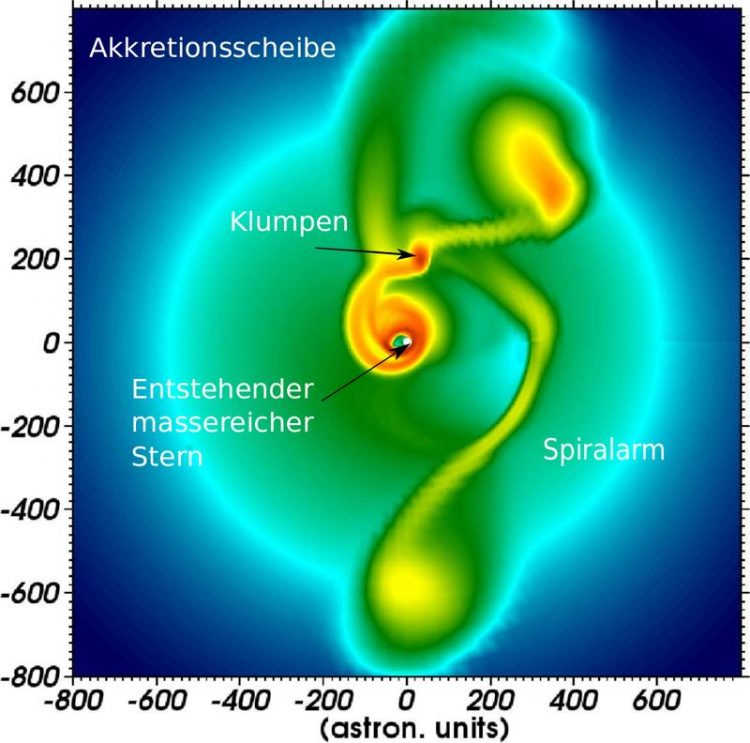The birth of massive stars is accompanied by strong luminosity bursts

Visualization of the unstable accretion disk around a forming massive star. Image: Institute for Astronomy and Astrophysics, Tübingen University
“How do massive stars form?” is one of the fundamental questions in modern astrophysics, because these massive stars govern the energy budget of their host galaxies. Using numerical simulations, Professor Wilhelm Kley, Dr. Rolf Kuiper and Dr. Dominique Meyer from the Institute for Astronomy and Astrophysics at the University of Tübingen in a collaboration with Dr. Eduard Vorobyov from the Institute for Astrophysics at the University of Vienna revealed new components of the formation of massive stars, which were already known from the formation process of low-mass as well as primordial stars. The study has now been published in the peer-review journal Monthly Notices of the Royal Astronomical Society.
The birth of massive stars is still a mystery to us, because these stars are embedded in an extremely dense medium of gas and dust, says Rolf Kuiper, the leader of the Emmy Noether Research Group for Massive Star Formation, funded by the German Research Foundation (DFG).
“This opaque envelope makes it difficult to directly observe the birth process even with modern telescopes. In other words, we see the cradle in which these stars are born, but we can’t detect the stars themselves.” Therefore, the researchers modeled the birth process within a numerical simulation. For this ambitious, computationally expensive study they made use of high-performance computers within the bwHPC initiative of the state of Baden-Württemberg.
The simulation starts with a cloud of gas and dust, which collapses under its own gravity and eventually forms a so-called accretion disk around the hot young star. The material in such a disk rotates around the central star and slowly transports gas and dust towards it. For the first time, the resolution of these simulations was sufficient to infer the formation of high-density clumps within the gravitationally unstable disk. Once formed, these clumps start to migrate through the disk and finally sink into the central star. “Like throwing logs into a fireplace, these episodes of clump consumption produce violent luminosity outbursts outshining the collective effect of one hundred thousand Suns,“ says Eduard Vorobyov.
A similar process of episodical luminosity bursts was already known with respect to the formation of the first stars in the Universe and for low-mass stars like our Sun. The new investigation suggests now that the formation of stars of any kind and epoch are controlled by the same universal processes: “It is amazing to see these similarities, as if star formation on all scales and epochs is controlled by a common DNA forged in the early Universe,“ says Dominique Meyer, the first author of the study and post-doc in the Emmy Noether Group. The clumps, explains Wilhelm Kley, are also excellent candidates for the formation of Solar-type companions to massive stars: “These companions will also influence their future evolution.”
The results will help to develop new observing strategies for detecting these luminosity outbursts – and even for directly imaging the high-density clumps in accretion disks around very young massive stars. This will be a task for modern observing facilities such as the Atacama Large Millimeter Array (ALMA) of the European Southern Observatory (ESO) or the future European Extremely Large Telescope (E-ELT).
Publication:
D. M.-A. Meyer, E. I. Vorobyov, R. Kuiper and W. Kley: On the existence of accretion-driven bursts in massive star formation. Monthly Notices of the Royal Astronomical Society, DOI: 10.1093/mnrasl/slw187, http://mnrasl.oxfordjournals.org/content/early/2016/09/15/mnrasl.slw187.abstract
Contact:
Prof. Dr. Wilhelm Kley
University of Tübingen
Institute for Astronomy and Astrophysics
Phone +49 7071 29-74007
wilhelm.kley[at]uni-tuebingen.de
Dr. Rolf Kuiper
University of Tübingen
Institute for Astronomy and Astrophysics
Emmy Noether Research Group for Massive Star Formation
Phone + 49 7071 29-75490
rolf.kuiper[at]uni-tuebingen.de
Dr. Eduard Vorobyov
University of Vienna
Institute for Astrophysics – Star and Planet Formation
Phone + 43 1 4277 538 15
eduard.vorobiev[at]univie.ac.at
http://www.tat.physik.uni-tuebingen.de/~msf – Emmy Noether Research Group on Massive Star Formation
http://www.physik.uni-tuebingen.de/institute/astronomie-astrophysik/institut.htm… – Institute for Astronomy and Astrophysics Tübingen
http://www.univie.ac.at/stars/ – Star & Planet Formation Group of the Department of Astrophysics Vienna
http://www.bwhpc-c5.de/ – High-performance Cluster Coordination bwGrid Baden-Württemberg
Media Contact
All latest news from the category: Physics and Astronomy
This area deals with the fundamental laws and building blocks of nature and how they interact, the properties and the behavior of matter, and research into space and time and their structures.
innovations-report provides in-depth reports and articles on subjects such as astrophysics, laser technologies, nuclear, quantum, particle and solid-state physics, nanotechnologies, planetary research and findings (Mars, Venus) and developments related to the Hubble Telescope.
Newest articles

Hyperspectral imaging lidar system achieves remote plastic identification
New technology could remotely identify various types of plastics, offering a valuable tool for future monitoring and analysis of oceanic plastic pollution. Researchers have developed a new hyperspectral Raman imaging…

SwRI awarded $26 million to develop NOAA magnetometers
SW-MAG data will help NOAA predict, mitigate the effects of space weather. NASA and the National Oceanic and Atmospheric Administration (NOAA) recently awarded Southwest Research Institute a $26 million contract…

Protein that helps cancer cells dodge CAR T cell therapy
Discovery could lead to new treatments for blood cancer patients currently facing limited options. Scientists at City of Hope®, one of the largest and most advanced cancer research and treatment…



